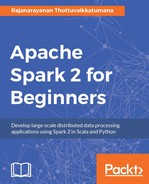Book Description
Develop large-scale distributed data processing applications using Spark 2 in Scala and Python
About This Book- This book offers an easy introduction to the Spark framework published on the latest version of Apache Spark 2
- Perform efficient data processing, machine learning and graph processing using various Spark components
- A practical guide aimed at beginners to get them up and running with Spark
If you are an application developer, data scientist, or big data solutions architect who is interested in combining the data processing power of Spark from R, and consolidating data processing, stream processing, machine learning, and graph processing into one unified and highly interoperable framework with a uniform API using Scala or Python, this book is for you.
What You Will Learn- Get to know the fundamentals of Spark 2 and the Spark programming model using Scala and Python
- Know how to use Spark SQL and DataFrames using Scala and Python
- Get an introduction to Spark programming using R
- Perform Spark data processing, charting, and plotting using Python
- Get acquainted with Spark stream processing using Scala and Python
- Be introduced to machine learning using Spark MLlib
- Get started with graph processing using the Spark GraphX
- Bring together all that you've learned and develop a complete Spark application
Spark is one of the most widely-used large-scale data processing engines and runs extremely fast. It is a framework that has tools that are equally useful for application developers as well as data scientists.
This book starts with the fundamentals of Spark 2 and covers the core data processing framework and API, installation, and application development setup. Then the Spark programming model is introduced through real-world examples followed by Spark SQL programming with DataFrames. An introduction to SparkR is covered next. Later, we cover the charting and plotting features of Python in conjunction with Spark data processing. After that, we take a look at Spark's stream processing, machine learning, and graph processing libraries. The last chapter combines all the skills you learned from the preceding chapters to develop a real-world Spark application.
By the end of this book, you will have all the knowledge you need to develop efficient large-scale applications using Apache Spark.
Style and approachLearn about Spark's infrastructure with this practical tutorial. With the help of real-world use cases on the main features of Spark we offer an easy introduction to the framework.
